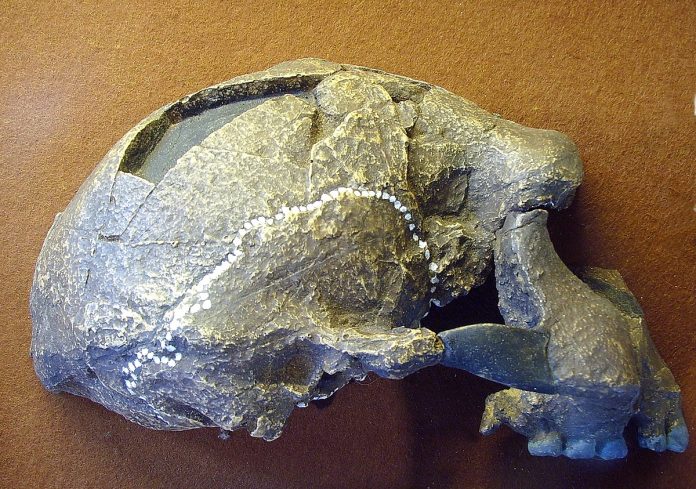
I’m not sure how much of Dr. Robin May’s presentation (posted below) of the human fossil record is science, or fiction – like most hypothetical theories without a whole lot of evidence, probably a bit of both, and I would tend more heavily towards the latter than the former. The bones, when one delves into what they actually have, are rather scanty, and open to various interpretations, to say the least. Were these partial-skeletons and bone fragments ‘human’ at all? There have been frauds and false hypotheses before.
The notion of a ‘species’ is itself a fraught one, especially as it applies to humans. In Linnaeus’ classification of the animal kingdom – kingdom, phylum, class, order, family, genus, species – the last category, the most ‘specific’ one, is delineated by those who could inter-breed and produce viable offspring. If early humans could all interbreed, then they were all the same species. Applying Linnaeus’ classfication, there would be the genus of ‘Homo’, then various species – Homo Habilis, Homo Neanderthalensis, and so on – with ourselves being, of course, the most recent iteration: Homo Sapiens, ‘wise man’, no irony intended.
Dr. Robin May, in the video below, is at great pains not to imply any sense that one species was ‘better’ than another, far less any notion of current gradations of being more, or less, human. Perhaps he is not aware that the one most famous for developing the notion of the evolution of humans from non-human creatures, the old boy Charles Darwin himself, was a dyed-in-the-wool racist. Darwin believed, and his theory implies, that evolution is always happening, as organisms develop from the ‘less fit’ to the ‘more fit’, or, in his word, more ‘civilized’, which one would think were a moral evolution, not a physiological one.
Whatever the case, the implication is that organisms – including humans – are gradually getting more perfect and genetically superior.
Here are Darwin’s own words:
At some future period, not very distant as measured by centuries, the civilized races of man will almost certainly exterminate and replace throughout the world the savage races. At the same time the anthropomorphous apes [that is, the ones which look most like the savages in structure] … will no doubt be exterminated. The break will then be rendered wider, for it will intervene between man in a more civilized state, as we may hope … the Caucasian, and some ape as low as a baboon, instead of as at present between the negro or Australian and the gorilla. (The Descent of Man, p. 105)
There are no ‘species’, in the strict and stable sense, in Darwin’s theory, for evolution is always happening – it is fluid, like the river of Heraclitus. Underlying Darwin’s vague, undigested metaphysics is rank nominalism and monism – just matter under random forces and pressures, ever-changing and morphing. What we call ‘species’ are simply semi-stable organisms happening to find a temporary niche. Hence, Darwin’s theory does not necessarily imply racism, or any implied growth in objective, a priori notions of ‘perfection’ – only that an animal is better adapted to its environment, and more able to get food and reproduce, which is a purely practical affair, which may imply any number of things, and in many cases is unpredictable. In our own current human ecological niche, a pencil-necked computer coder can access more food and funds, live in a bigger house, and drive a nicer car, than a musclebound brute who’s real good at haulin’ lumber around.
Being human is not really about that though, is it? The Church has cut through this nonsense, with Pius XII in his 1950 encyclical Humani Generis, declaring that all humans descend, by natural generation, from Adam and Eve. This is the doctrine of monogenesis:
When, however, there is question of another conjectural opinion, namely polygenism, the children of the Church by no means enjoy such liberty. For the faithful cannot embrace that opinion which maintains that either after Adam there existed on this earth true men who did not take their origin through natural generation from him as from the first parent of all, or that Adam represents a certain number of first parents. Now it is in no way apparent how such an opinion can be reconciled with that which the sources of revealed truth and the documents of the Teaching Authority of the Church propose with regard to original sin, which proceeds from a sin actually committed by an individual Adam and which, through generation, is passed on to all and is in everyone as his own. (#36)
That is, there’s only one ‘species’ of Man, within the genus ‘Homo’ – the sapiens sort, if you want to us that term. We are all one kind and race, always have been, always will be; all of us are created by God in His image, an image that has been compromised by original sin; but we are all destined, if we live a life of virtue and cooperate with His grace, to spend eternal life in His presence in beatitude.
So, to answer Dr. Robin May’s question, the reason there is only one kind of human is that God made us that way, and His Christ took that nature to redeem us. So we will remain, our human nature immutable, until the same Christ returns in glory, to bring that nature to its full supernatural perfection.
